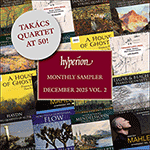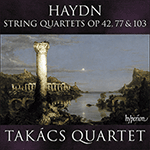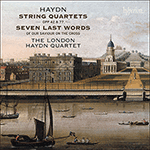
Welcome to Hyperion Records, a British classical label devoted to presenting high-quality recordings of music of all styles and from all periods from the twelfth century to the twenty-first.
Hyperion offers both CDs, and downloads in a number of formats. The site is also available in several languages.
Please use the dropdown buttons to set your preferred options, or use the checkbox to accept the defaults.
The quartet’s outward simplicity, epitomized by the first movement’s unusual marking ‘andante ed innocentemente’, belies its subtle mastery. In each movement Haydn delights in making much of little. The opening movement, with its graceful dialogue textures, grows ingeniously from the three distinct motifs of its sole theme. The tone is one of subdued melancholy, flaring briefly to an intense climax near the end. True to form, Haydn continues to draw new meanings from the theme right through to the end.
The minuet, in D major, shares the first movement’s motivic concentration and easy, conversational give-and-take. Its gliding, almost Mozartian elegance is offset by a laconic D minor trio that works its initial bars in quasi-canonic imitation. True to the thematic economy of the whole quartet, the serene adagio is in essence a meditation on its tranquil opening phrase, unfolding in rich, glowing textures.
As in several of Haydn’s early symphonies (and like Mozart in his G major quartet, K387), the finale fuses the ‘learned’ and ‘popular’ styles, alternating stern passages of invertible counterpoint with music that could have tumbled straight out of a comic opera. There are also moments of hushed mystery where surface activity virtually ceases. The upshot is a movement both tense and witty, not least when Haydn keeps us guessing as to the exact point where the development ends and the recapitulation begins.
from notes by Richard Wigmore © 2022
La simplicité apparente de ce quatuor, incarnée par l’indication inhabituelle du premier mouvement «andante ed innocentemente», contredit sa maîtrise subtile. Dans chaque mouvement, Haydn prend plaisir à tirer un maximum de peu de choses. Le mouvement initial, avec ses élégantes textures de dialogue, se développe ingénieusement à partir des trois motifs distincts de son unique thème. Le ton est celui de la mélancolie morose, s’enflammant brièvement pour atteindre un sommet intense à la fin. Fidèle à la forme, Haydn continue à puiser de nouvelles acceptions du thème jusqu’à la fin.
Le menuet, en ré majeur, partage la concentration des motifs et les échanges de conversation pleins d’aisance du premier mouvement. Son élégance glissante, presque mozartienne, est compensée par un trio laconique en ré mineur avec ses premières mesures en imitation quasi canonique. Fidèle à l’économie thématique de tout ce quatuor, l’adagio serein est par essence une méditation sur sa phrase initiale tranquille, qui se déroule en textures riches et chaudes
Comme dans plusieurs symphonies de jeunesse de Haydn (et comme Mozart dans son quatuor en sol majeur, K387), le finale fait fusionner les styles «savant» et «populaire», avec une alternance entre des passages graves en contrepoint renversable et une musique qui aurait pu jaillir directement d’un opéra-comique. Il y a aussi des moments de mystère feutré où l’activité de surface cesse pratiquement. Le résultat est un mouvement à la fois tendu et spirituel, surtout lorsque Haydn nous laisse deviner le moment exact où s’achève le développement et où commence la réexposition.
extrait des notes rédigées par Richard Wigmore © 2022
Français: Marie-Stella Pâris
Die äußere Schlichtheit des Quartetts, verkörpert durch die ungewöhnliche Bezeichnung des ersten Satzes, „Andante ed innocentemente“, täuscht über seine subtile Meisterschaft hinweg. In jedem Satz macht sich Haydn ein Vergnügen daraus, mit sparsamen Mitteln viel zu erreichen. So entwickelt sich der Kopfsatz mit seinen anmutigen Dialogstrukturen auf geniale Weise aus den drei verschiedenen Motiven seines einzigen Themas. Der Ton ist gedämpft-melancholisch, gegen Ende flackert kurz ein intensiver Höhepunkt auf. In bewährter Weise gewinnt Haydn dem Thema bis zum Schluss immer wieder neue Bedeutungen ab.
Das Menuett in D-Dur hat eine ähnliche motivische Konzentration wie der erste Satz, wie auch jenes leichte, gesprächige Geben und Nehmen. Der dahingleitenden, fast Mozart’schen Eleganz steht ein lakonisches d-Moll-Trio gegenüber, dessen ersten Takte in quasi-kanonischer Imitation gesetzt sind. Getreu der thematischen Ökonomie des gesamten Quartetts ist das heitere Adagio im Wesentlichen eine Meditation über die ruhige Anfangsphrase, die sich in reichen, leuchtenden Strukturen entfaltet.
Wie in mehreren frühen Haydn-Sinfonien (und wie in Mozarts G-Dur Quartett KV 387) verschmelzen im Finale der „gelehrte“ und der „volkstümliche“ Stil, wobei strenge Passagen mit umkehrbarem Kontrapunkt mit Musik alternieren, die direkt aus einer komischen Oper stammen könnte. Es gibt auch Momente von stiller Geheimniskrämerei, in denen die Oberflächenaktivität praktisch zum Stillstand kommt. Das Ergebnis ist ein Satz, der sowohl spannend als auch witzig ist, nicht zuletzt, wenn Haydn uns im Unklaren darüber lässt, wo genau die Durchführung endet und die Reprise beginnt.
aus dem Begleittext von Richard Wigmore © 2022
Deutsch: Viola Scheffel
 Hyperion sampler - December 2025 Vol. 2 Hyperion sampler - December 2025 Vol. 2 |
 Haydn: String Quartets Opp 42, 77 & 103 Haydn: String Quartets Opp 42, 77 & 103‘Does it need saying that they’re awfully good?’ was The Strad’s rhetorical take on the Takács Quartet’s previous Haydn recordings for Hyperion. With more marvellous Haydn on offer here—the Takács acutely sensitive to the lifetime’s experience imb ...» More |
 Haydn: String Quartets Opp 42, 77 & Seven Last Words Haydn: String Quartets Opp 42, 77 & Seven Last WordsHaydn’s ‘Seven Last Words’—heard here in the composer’s own arrangement for string quartet—is simply sublime. It provides an apt and generous coupling for the two magnificent Op 77 quartets, Haydn’s final complete contribution to the string quarte ...» More |

